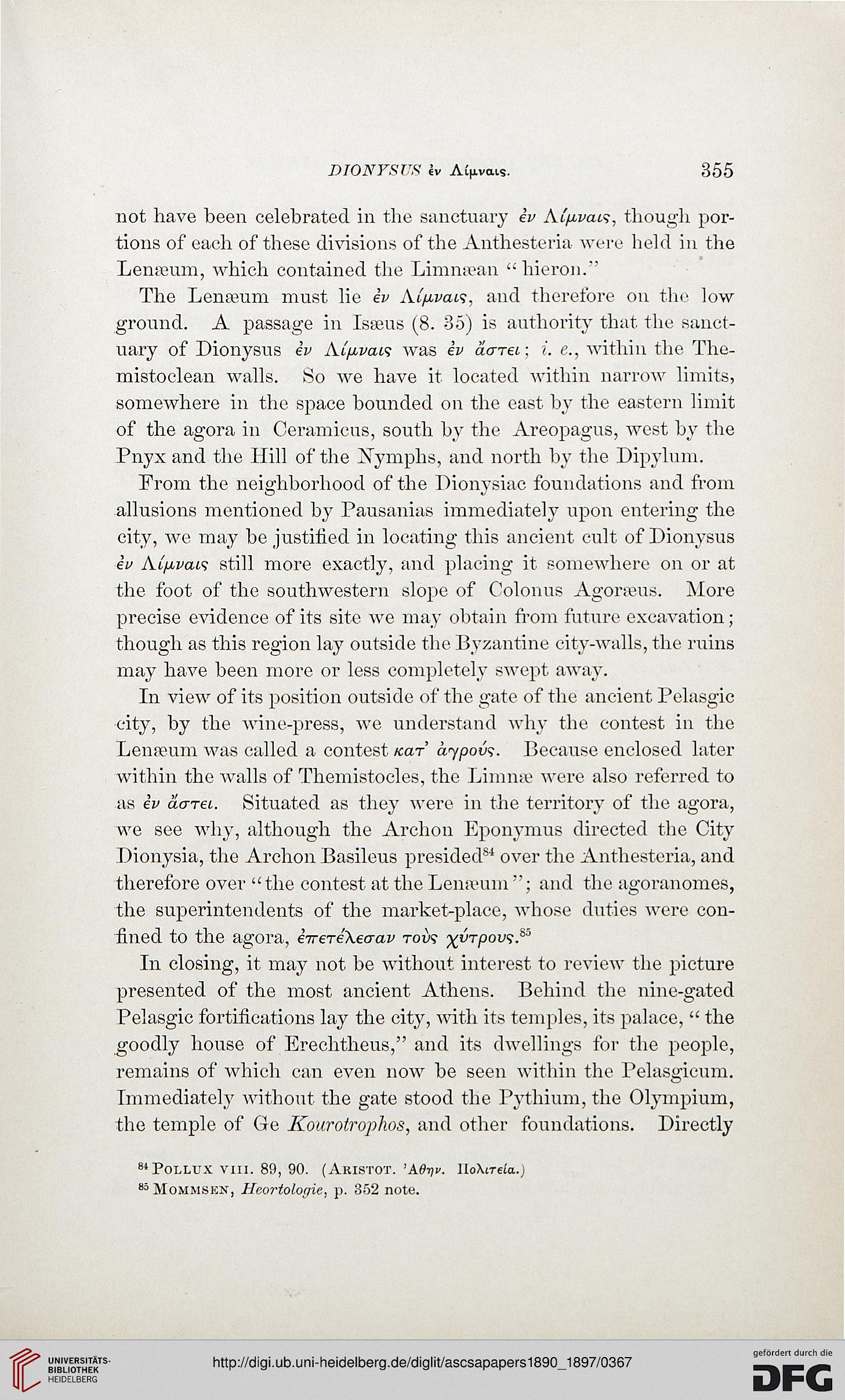DIONYSUS kv Atuvois.
355
not have been celebrated in the sanctuary iv A(fivai<s, though por-
tions of each of these divisions of the Anthesteria were held in the
Lenseum, which contained the Limnsean "hieron."
The Lenseum must lie iv Alfivai<i, and therefore on the low
ground. A passage in Isseus (8. 35) is authority that the sanct-
uary of Dionysus iv Aifivcus was ev aa-rei: i. e., within the The-
mistoclean walls. So we have it located within narrow limits,
somewhere in the space bounded on the east by the eastern limit
of the agora in Ceramicus, south by the Areopagus, west by the
Pnyx and the Hill of the Nymphs, and north by the Dipylum.
From the neighborhood of the Dionysiac foundations and from
allusions mentioned by Pausanias immediately upon entering the
city, we may be justified in locating this ancient cult of Dionysus
iv Aifj,vai<; still more exactly, and placing it somewhere on or at
the foot of the southwestern slope of Colonus Agorseus. More
precise evidence of its site Ave may obtain from future excavation;
though as this region lay outside the Byzantine city-walls, the ruins
may have been more or less completely swept away.
In view of its position outside of the gate of the ancient Pelasgic
city, by the wine-press, we understand why the contest in the
Lenseum was called a contest /car aypovs. Because enclosed later
within the walls of Themistocles, the Limine were also referred to
as iv da-rei. Situated as they were in the territory of the agora,
we see why, although the Archon Eponymus directed the City
Dionysia, the Archon Basileus presided84 over the Anthesteria, and
therefore over "the contest at the Lemeum "; and the agoranomes,
the superintendents of the market-place, whose duties were con-
fined to the agora, iirereXeaav rou? %VTpov<;.Sb
In closing, it may not be without interest to review the picture
presented of the most ancient Athens. Behind the nine-gated
Pelasgic fortifications lay the city, with its temples, its palace, " the
goodly house of Erechtheus," and its dwellings for the people,
remains of which can even now be seen within the Pelasgicum.
Immediately without the gate stood the Pythium, the Olympium,
the temple of Ge Kourotrophos, and other foundations. Directly
84 Pollux vol, 89, 90. (Aristot. 'k8i)v. lloXireia.j
^mommskn, Heoriologie, p. 352 note.
355
not have been celebrated in the sanctuary iv A(fivai<s, though por-
tions of each of these divisions of the Anthesteria were held in the
Lenseum, which contained the Limnsean "hieron."
The Lenseum must lie iv Alfivai<i, and therefore on the low
ground. A passage in Isseus (8. 35) is authority that the sanct-
uary of Dionysus iv Aifivcus was ev aa-rei: i. e., within the The-
mistoclean walls. So we have it located within narrow limits,
somewhere in the space bounded on the east by the eastern limit
of the agora in Ceramicus, south by the Areopagus, west by the
Pnyx and the Hill of the Nymphs, and north by the Dipylum.
From the neighborhood of the Dionysiac foundations and from
allusions mentioned by Pausanias immediately upon entering the
city, we may be justified in locating this ancient cult of Dionysus
iv Aifj,vai<; still more exactly, and placing it somewhere on or at
the foot of the southwestern slope of Colonus Agorseus. More
precise evidence of its site Ave may obtain from future excavation;
though as this region lay outside the Byzantine city-walls, the ruins
may have been more or less completely swept away.
In view of its position outside of the gate of the ancient Pelasgic
city, by the wine-press, we understand why the contest in the
Lenseum was called a contest /car aypovs. Because enclosed later
within the walls of Themistocles, the Limine were also referred to
as iv da-rei. Situated as they were in the territory of the agora,
we see why, although the Archon Eponymus directed the City
Dionysia, the Archon Basileus presided84 over the Anthesteria, and
therefore over "the contest at the Lemeum "; and the agoranomes,
the superintendents of the market-place, whose duties were con-
fined to the agora, iirereXeaav rou? %VTpov<;.Sb
In closing, it may not be without interest to review the picture
presented of the most ancient Athens. Behind the nine-gated
Pelasgic fortifications lay the city, with its temples, its palace, " the
goodly house of Erechtheus," and its dwellings for the people,
remains of which can even now be seen within the Pelasgicum.
Immediately without the gate stood the Pythium, the Olympium,
the temple of Ge Kourotrophos, and other foundations. Directly
84 Pollux vol, 89, 90. (Aristot. 'k8i)v. lloXireia.j
^mommskn, Heoriologie, p. 352 note.




